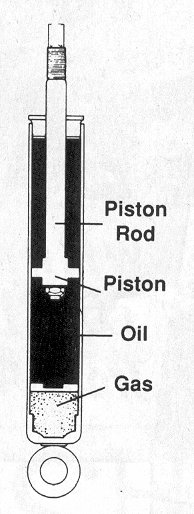|
Monotube The final type of shock absorber is the monotube damper or high-pressure gas shock, which relies on a single pressure tube with all shock valving controlled by the piston valve. There are no external reservoirs as in the case of twin-tube shocks. To allow for the space necessary to accommodate the shock fluid displaced by the piston rod, monotube shocks typically utilize high-pressure gas (between 250 and 400 psi), completely separated by a floater piston so the oil and gas never mix. Advantages include an ability to dissipate heat more efficiently, offering the smallest fade potential of the bunch, and an ability to be mounted upside down. Generally speaking, high-pressure gas shocks have the potential to last along time. Disadvantages include, due to their construction and internal high pressure, a susceptibility to side loads and dents (monotubes can be mounted upside down). A small dimple can all but mangle the shock's proper piston/cylinder clearances; however, to compensate for this, monotube manufacturers tend to make their shock walls relatively thick. Because containing gas within a shock at very high pressures requires very precise manufacturing, the high-pressure monotube gas shock is the most expensive of all shock types. The seal at the top of the tube is critical, so if significant side-loads are anticipated, Heim-joint mounting is the way to go. |
 |